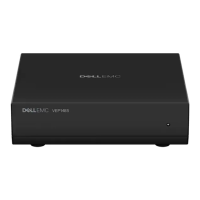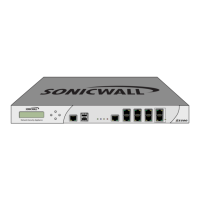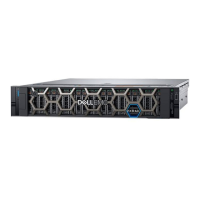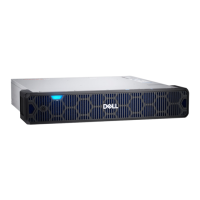Table 1. Features available on the front of the system (continued)
Item Ports, panels, and
slots
Icon Description
● Quick Sync 2 (wireless): Indicates a Quick Sync enabled
system. The Quick Sync feature is optional. This feature
allows management of the system by using mobile devices.
This feature aggregates hardware or firmware inventory
and various system level diagnostic and error information
that can be used in troubleshooting the system. For
more information, see the Integrated Dell Remote Access
Controller User’s Guide at Dell.com/idracmanuals.
2 Video connector Enables you to connect a display device to the system. For more
information, see Technical specifications on page 19.
3 Right control panel N/A Contains the power button, USB port, iDRAC Direct micro port,
and the iDRAC Direct status LED.
4 USB port (optional)
The USB port is USB 3.0 compliant.
5 Hard drive slots N/A Enable you to install hard drives that are supported on your
system. For more information about hard drives, see Technical
specifications on page 19.
Left control panel view
Figure 3. Left control panel with optional iDRAC Quick Sync 2.0 indicator
Table 2. Left control panel
Item Indicator or button Icon Description
1 Status LED indicators N/A Indicate the status of the system. For more information, see
Status LED indicators on page 9.
2
System health and system
ID indicator
Indicates the system health. For more information, see System
health and system ID indicator codes on page 9.
3 iDRAC Quick Sync
2 wireless indicator
(optional)
Indicates if the iDRAC Quick Sync 2 wireless option is activated.
The Quick Sync 2 feature allows management of the system
using mobile devices. This feature aggregates hardware/
firmware inventory and various system level diagnostic/error
information that can be used in troubleshooting the system.
You can access system inventory, Dell Lifecycle Controller logs
or system logs, system health status, and also configure iDRAC,
BIOS, and networking parameters. You can also launch the
virtual Keyboard, Video, and Mouse (KVM) viewer and virtual
Kernel based Virtual Machine (KVM), on a supported mobile
8 XC640 Series and XC Core system overview

